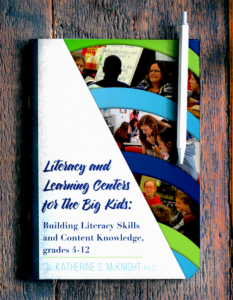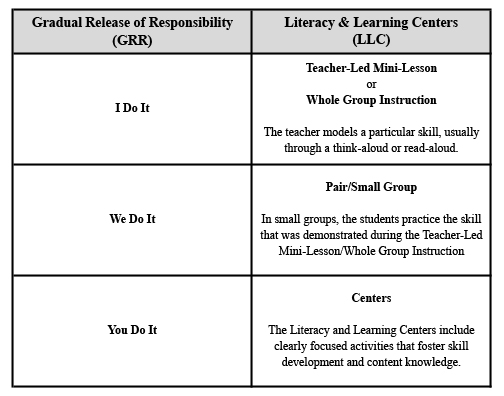Literacy & Learning Centers for the Big Kids

Every middle school teacher faces the same challenge: cover a huge amount of content, support literacy development, prepare students for important evaluations, and accommodate the social demands of adolescence – all while somehow managing to meet every student’s unique needs.
When I hear publishers and product developers claim that they have a one-size-fits-all, effortless way to improve student learning, well, let’s just say I’m circumspect.
I know how hard it is, I know how hard teachers work, and I know the solution can’t be purchased.
My 30-plus years of classroom experience confirm my belief that effective teaching and learning is grounded in the relationship between teacher and student. Classroom innovations come and go, but that relationship is the one thing that always remains constant.
That’s why, for the past six years, I’ve worked with teachers in schools all over the country to develop and fine tune a Literacy & Learning Center (LLC) model for grades 4–12.
When most teachers think of centers, we identify them with the K-3 classroom. But when the model is expanded and adapted for middle grades students, it incorporates many of the essential elements that successful middle level schools strive for:
- balanced literacy,
- content knowledge acquisition,
- kinesthetic learning,
- differentiated instruction,
- formative assessment, and
- response to intervention.
All that, and the LLC model doesn’t require teachers or schools to purchase anything!
The Advantages of LLC for Kids and Teachers
As I implemented the Literacy & Learning Center model in countless schools, the tangible advantages became clear. The combination of self-directed activities and short, specific tasks lent itself to the natural strengths of middle school students.
Quite simply, they tended to be more engaged in their learning when they worked in centers. During self-reflection, the students often reported that it was easier for them to focus and they felt more empowered to ask questions.
Teachers who use the model report that even their most reluctant learners don’t complain of being bored. On the contrary, students claim that time passes quickly as they collaborate with peers, learn content, and reinforce skill development. Teachers agree that discipline problems fade away as the self-directed activities provide the independence the students crave – with the guidance they need.
Perhaps the most astounding thing of all, teachers discovered that the LLC model enabled them to cover more content in less time. And in special teacher-led centers, they had an opportunity to provide personalized instruction and individual formative assessment of each student.
On average, the schools in which Literacy & Learning Centers were implemented effectively saw student achievement on national assessments (such as PARCC and NAEP) rise between 13-18% in one academic year. This is a staggering statistic and the success can be attributed to the fact that middle school students learn better when they are doing rather than just passively accepting instruction.
Key Pedagogical Research-based Philosophies Grounding the LLC Model
Balanced Literacy – Substantial literacy research has established the importance of integrating reading, writing, speaking, listening, vocabulary, and language in a synergetic instructional approach. In this model, students are provided with ample opportunities to develop their literacy skills in multiple contexts—through integration, not isolation.

Differentiated Instruction – We know that all of our students are not the same. Yet when teachers are faced with large classes, how can we provide individual instruction and choice as the differentiated instructional model promotes? Through Literacy & Learning Centers, teachers can create learning activities that allow for student choice, flexible grouping, and modification of skills.
Multi-Tiered Intervention – As a key component for closing the student achievement gap, multi-tiered interventions are offered in response to student data or other classroom performance information. When educators are able to target individual students and provide specific interventions to improve skill development, students are less likely to fall behind. In the LLC model these interventions can be addressed in the teacher-led center as well as in the individual centers.
Gradual Release of Responsibility – The Literacy & Learning Center framework shifts the focus of learning onto the student, while the teacher provides modeling and guidance through structured activities. When Literacy & Learning Centers are aligned with the Gradual Release of Responsibility (GRR) model, students can work toward developing a greater range of skills in order to increase more independent learning.
How the LLC Model Works Across Content
Although there are suggested structures for the model, it’s important to remember that it is malleable. It can easily be adapted for any content area, and there are ample opportunities to incorporate technology into the centers.
Step One: Teacher-Led Instruction – This is an opportunity for the teacher to begin the lesson with a whole-group mini- lesson that models a skill for students. In the GRR framework, this is the “I Do It” component. In short, the Literacy & Learning Center approach begins with teacher modeling. This modeling provides the foundation for the student practice (“We Do It”) and the center time (“You Do It”) that will follow the teacher-led instruction.
Step Two: Student Practice – In the GRR framework, this is the “We Do It” component. During this time, the students work in pairs or small groups to practice the skill or discuss the content that was introduced by the teacher in Step One. The idea is for students to have ample practice time in order to develop skills and content knowledge. This is an integral factor for successful LLC implementation, and it is especially important in light of Richard Allington’s research (2012) about schools that are able to close the student achievement gap in literacy. Practice is critical.
Step Three: Center Time – This is an opportunity for small teams of 3–5 students to work together in centers. No matter what your area of expertise is, I always recommend starting with what I call the four foundational centers: teacher-led center, vocabulary, writer’s craft and reading together. Depending on the content area, teachers can add even more centers.
Each center consists of a clearly articulated activity that promotes student independence, provides practice, and develops skills and content knowledge. In the GRR framework, center time represents the “You Do It” component. I advise teachers to start small, introducing a limited number of centers one day a week. Then, as students get comfortable with the procedures and teachers get comfortable with their new role of facilitator rather than lecturer, they can add more centers. The results will be dramatic and positive.
Building a Collaborative Classroom Community for All Students
The Literacy & Learning Center model is based on my work and experiences in classrooms, and it is built on research that indicates the best practices for the development of literacy skills. Imagine grade 4–8 students developing literacy skills and content knowledge in an engaged classroom setting, as part of a collaborative classroom community. Isn’t this what we want for all of our students?
Resources: Lesson Ideas for Literacy and Learning Centers
Note: Thanks to Katie McKnight for sharing these lesson resources from her upcoming book Literacy & Learning Centers: Engaging Learners Classroom Tools – Volume 1.
Snapchat the Main Point – (download lesson)
- Description: After reading a text together, students work in teams to summarize the author’s main point using nothing but a quick sketch and 80 or fewer characters.
- Skills: Students work together on reading goals (identifying a central idea, summarization, citing evidence), speaking & listening goals (conversation, reasoning, citing evidence, presenting information), and writing goals (task/purpose/audience, production, planning, revising and editing).
- This activity can be used in the following center(s): Reading Together, Writer’s Craft, Speaking & Listening, and Teacher-Led
Defragging Sentence Fragments – (download lesson)
- Description: In this activity, students match up two sentence fragments to create one complete sentence about the course content.
- Skills: Students practice recognizing the difference between sentence fragments and complete sentences. They then craft complete sentences to express clear ideas about content.
- This activity can be used in the following center(s): Grammar and Writer’s Craft
Lexicographer: or Write Your Own Dictionary – (download lesson)
- Description: A lexicographer is someone who writes dictionary definitions. In this activity, students gather their own list of unfamiliar or unusual words during independent reading and, at the vocabulary center, enter them into their own personal dictionaries.
- Skills: When they keep a personal record of newly acquired vocabulary words, students learn vocabulary as an aspect of self-directed and self-regulated learning. They practice using context clues and reference materials to determine word meanings, and they explore the relationship between word forms.
- This activity can be used in the following center(s): Vocabulary
Teacher Tip: Start Small and Grow –
- Description: The centers model works in so many contexts! I advise teachers to start small, adding a limited number of centers one or two days a week. Then, as students get comfortable with the procedures and teachers get comfortable with their new role as facilitator, add more.
- Linked content: Watch this great video (and download this guide). It’s the Literacy & Learning Center model in action in East St. Louis, IL.






































Thank you for your post about learning centers in middle schools, Katherine. The classroom teachers, specialists, and students with whom I have worked as a school librarian have had success with learning centers at all grade levels, including high school. I hope Middle Blog readers will consider their school librarians as partners in planning for and facilitating learning centers. I also hope readers will consider the library itself as an ideal location (with lots of space to spread out and access to resources and technology) as an optimum location for learning centers.